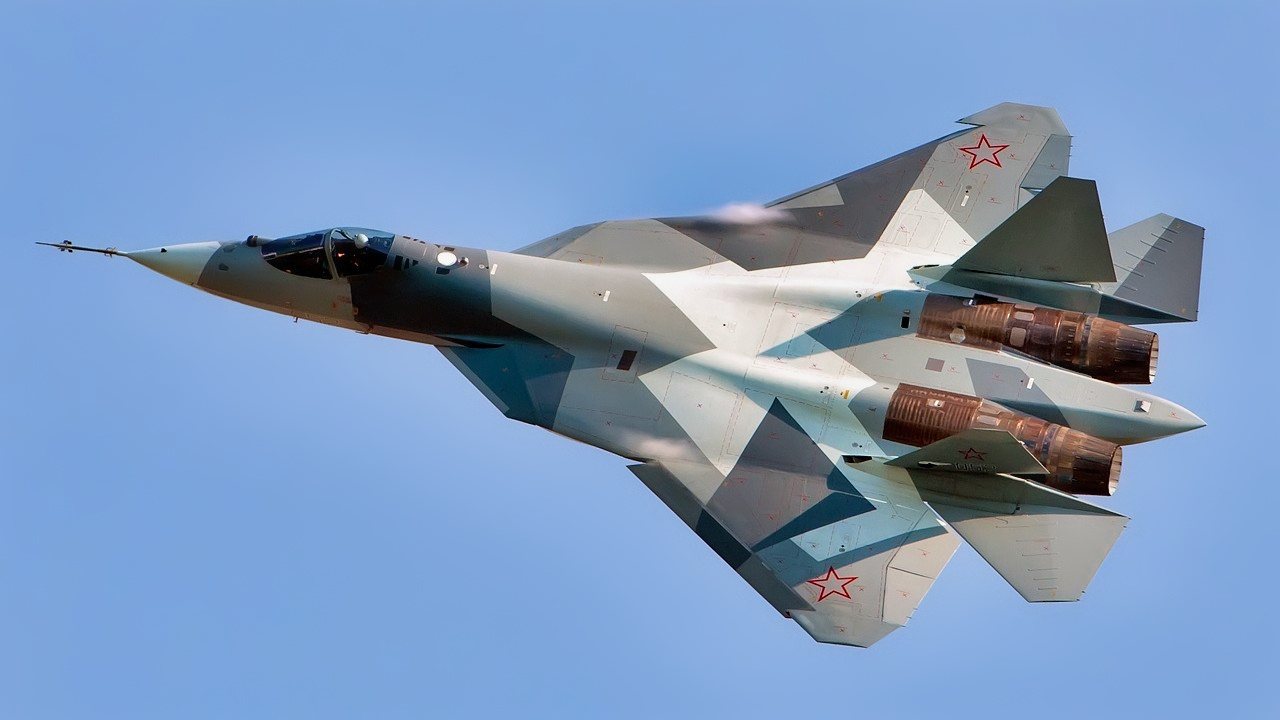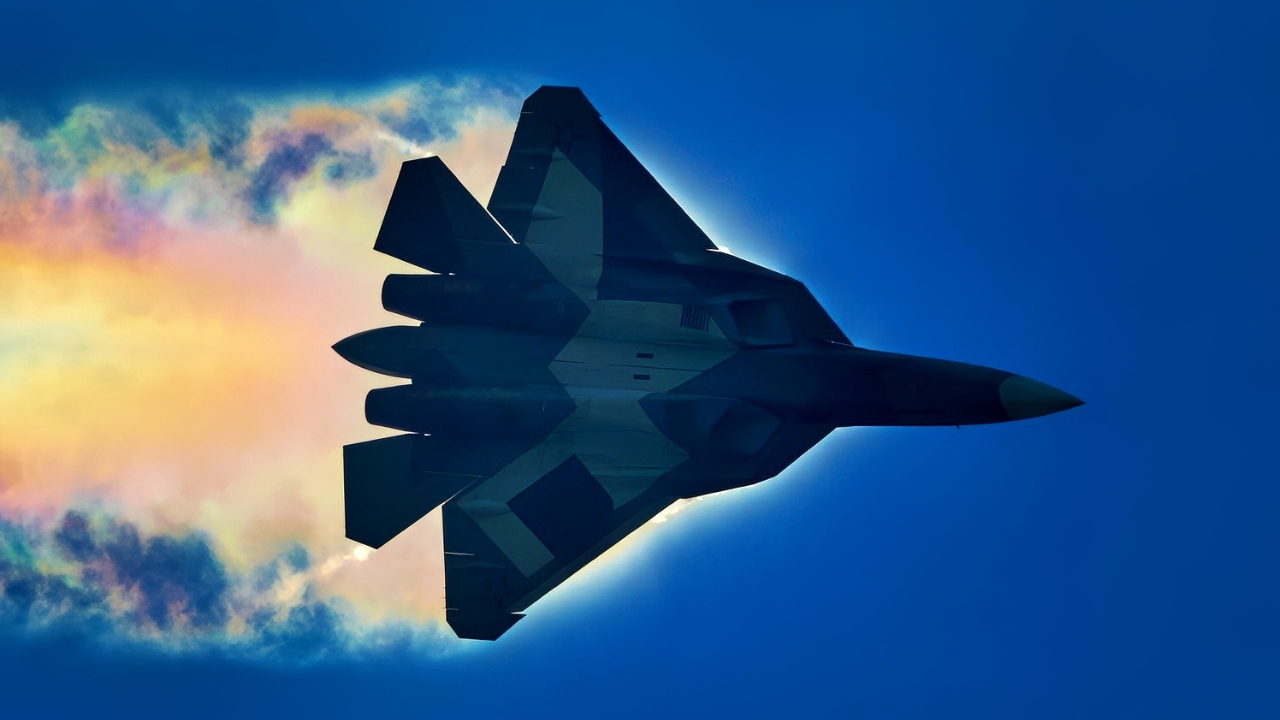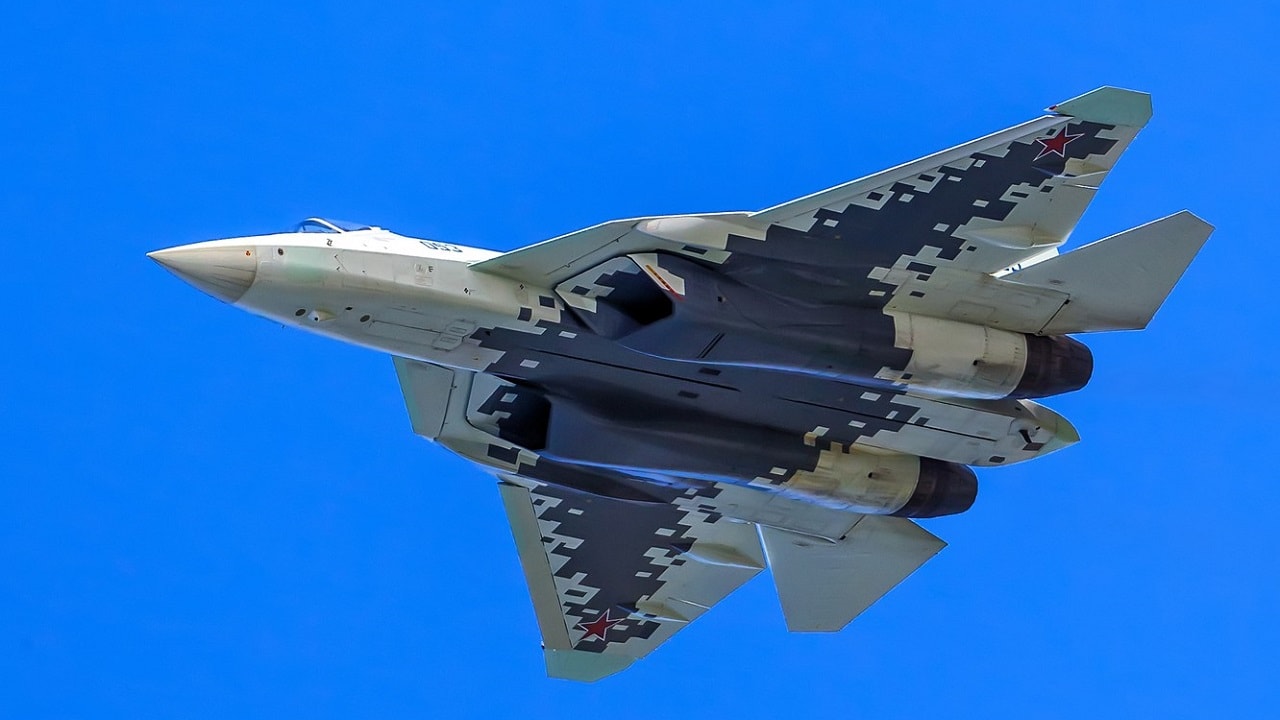Key Points and Summary – Russia’s Su-57 Felon isn’t chiefly a design failure; it’s a resourcing failure.
-By starving the program early, Moscow forfeited the scale that makes fifth-generation fleets powerful: production learning, supplier depth, software maturity, and a sustainment backbone.

Su-57 Felon Fighter Russian Ministry of Defense Photo

Russia PAK-FA or Su-57 Felon. Image Credit: Creative Commons.
-In Ukraine, the few Su-57s fly cautiously—standoff strikes from Russian airspace—because a boutique fleet can’t absorb risk.
-Had Russia funded series production in the late 2010s, it could have fielded scores of jets today, tested its doctrine, and courted exports.
-Instead, the U.S. and China massed fifth-gen fleets and are already moving on to sixth-gen programs.
-The Su-57’s lesson is simple: you can’t surge what you never built.
Russia’s Su-57 Felon: A Boutique Fleet In A World Of Mass Production
If you judge a stealth fighter program purely by glossy mock-ups and airshow flybys, Russia’s Su-57 looks competitive enough. And, to be frank, I have been writing about this stealth fighter for years.
However, for me, there has always been a fatal flaw in the Su-57 Felon fighter program that I don’t think I have touched on enough: if you judge it by what wins wars—production volume, sortie rates, mature weapons, and a global sustainment spine—the picture looks grim. Moscow’s central error with the Su-57 wasn’t a single design flaw or a fatal misread of stealth physics.
It was a resourcing choice: starving the program during the years when scale, suppliers, and software needed compounding investment. That “too little, too late” decision left Russia with a boutique fleet at the very moment air forces that matter measure combat power in hundreds of fifth-gen jets and are already funding the sixth-generation follow-ons.
This is a story about opportunity cost. Had Russia funded Su-57 like an urgent national project—before sanctions bit, before the Ukraine war soaked up budgets—it could plausibly field scores of aircraft today, harvest learning curves, and use that scale to attract export partners. Instead, Moscow is years into a conflict that has exposed industrial fragility, and the Su-57 remains rare, cautious, and strategically underwhelming.
What Moscow Wanted—And What It Chose Not To Pay For
The Kremlin’s ambition for the Su-57 was sensible on paper: a low-observable, sensor-fused, long-range multirole platform that would anchor Russia’s tactical aviation for decades. The airframe promised internal weapons bays, composite structures, thrust-vector control, and a radar/EO suite to spot and swat at distance. With a clean production plan and stable cash flow, you could imagine a path to 150–200 airframes by the mid-2020s—enough to transform both doctrine and deterrence.
But ambition without investment is just a brochure. Throughout the 2010s, Russia invested money in prototypes and small batches. At the same time, key subsystems (engines, avionics, sensors) awaited the kind of rigorous engineering and supplier development that only emerges when production contracts are substantial. By the time Russia’s defense establishment tried to step on the gas, Western sanctions had eaten into materials, machine tools, chips, and finance, and the war in Ukraine began absorbing cash, manpower, and political attention.
The result: a program that never hit a virtuous cycle of scale.

Su-57 Felon Artist Image> Image Credit: Screenshot.

Su-57 Felon Fighter Back in 2011. Image Credit: Creative Commons.

Su-57 Felon Fighter Stealth. Image Credit: Creative Commons.
How A Starved Program Becomes A Boutique Fleet
Aircraft programs don’t “snap to” mass production because a leader pounds the table. They need three flywheels spinning together: (1) steady multi-year procurement so factories invest; (2) suppliers that see guaranteed demand and expand capacity; (3) software and sustainment teams that iterate quickly because hundreds of jets are flying daily. Russia underfunded all three.
Engines, The Long Pole. Early Su-57s rely on AL-41F1s rather than the elusive “Izdeliye 30” powerplant that would unlock the full performance envelope. Engine transitions are always hard; they get harder when your industry is sanction-strapped and you haven’t bought enough time (and test articles) to fail forward in parallel. That throttles production confidence and keeps airframes trickling out instead of flowing.
Composites, Avionics, And Mission Systems. Low observability is as much a manufacturing art as a design feature. It demands tight tolerances, stable material supplies, coatings discipline, and software that fuses sensors the way a modern fighter must. All of that is improved by scale. Starve the line, and your suppliers never reach rhythm; your rework rates stay high; your software maturity lags because the fleet isn’t flying enough hours to generate and fix bugs at speed.
Sustainment As A Design Variable. Fifth-gen sustainment depends on coating durability, parts commonality, and data-driven maintenance habits you only internalize when hundreds of tails are cycling through everyday grime. An exquisite, seldom-flown jet will not teach you what a hangar full of them will. Russia never funded that learning at a meaningful scale.
The proof is in the force structure: by mid-2020s, even Russian-state and industry outlets talk about “batches,” not brigades; “accelerating deliveries,” not saturation. If you must announce acceleration, you almost certainly never had momentum.
What Combat Has Shown—And What It Hasn’t
Yes, Su-57s have been used in the Ukraine war—but mostly in a way that telegraphs caution: long-range standoff shots launched from Russian airspace, experimenting with strike profiles and new munitions while avoiding Ukrainian SAM umbrellas.
(However, we must be clear, reports are all over the place on what it has actually done in Ukraine, so I want to start that upfront.)
There’s nothing illegitimate about that; survival is a valid tactic. But it’s telling. A genuinely mature fifth-gen fleet would be doing more than episodic standoff demos: it would be generating tempo, shaping the air picture deep and often, and soaking up operational data across squadrons.
One more datapoint: a Ukrainian strike damaging a Su-57 on the ground in 2024 did more than singe a jet—it punctured the aura around Russia’s stealth program and highlighted a base-defense and dispersal problem that multiplies when your fleet is tiny.
When you have few airframes, you protect them like crown jewels, which in turn limits how boldly you employ them.
The Arms Market Angle Russia Gave Up
If Russia had funded early mass production and delivered stable blocks into service, it could have parlayed the Su-57 Felon into a sales funnel: (1) show robust domestic fielding; (2) offer an exportable configuration; (3) cultivate a partner that co-finances upgrades. That is exactly how the United States made the F-35 more affordable—by enlisting allies as customers and stakeholders. Russia gestured in that direction with India a decade ago; the partnership fizzled amid delays, disagreements over requirements, and cost/transparency concerns. A program with momentum might have held New Delhi or courted another partner; a boutique fleet cannot.
Exportability isn’t just cash. It’s also politics and logistics: spares pooling, depot access, training pipelines, and a global narrative that your aircraft is “the standard.” The Su-57 missed its moment. Instead of being a magnet, it became a curiosity.
The Counterfactual: What Early Scale Would Have Bought
Imagine Russia had launched into true series production by the late 2010s: What would be different today?
Operational Confidence. Fifty or a hundred combat-coded jets force you to solve sortie generation, LO maintenance, and software updates for real. The first-year pain becomes year-five competence.
Doctrinal Muscle Memory. With scale, commanders experiment: multi-ship stealth packages, “quarterback” roles over contested zones, complex kill chains that require dozens of aircraft and many munitions types. Tactics get better because reps get higher.
Deterrence And Diplomacy. A credible number of stealth jets changes the geometry of regional airspace. It also changes how countries talk to you. “We have a handful” is a weaker message than “we have a wing or two, trained and ready.”
Export Leverage. A full-up, in-service Su-57 would be offered from a position of strength: “Join our upgrade road map.” That’s a very different pitch than “fund our completion.”
Would early scale have fixed every shortcoming? No. But aviation history is clear: scale fixes more than it breaks, because it compels the system to grow up.
Meanwhile, The Rest Of The World Didn’t Wait
The F-35 program—whatever one thinks of its cost history—has crossed the threshold that matters: thousands on order and well over a thousand delivered, with production lots still flowing and a software/hardware upgrade cadence that feeds on scale. That mass creates deterrence by itself. It also creates a deep bench of trained maintainers, spare parts, simulators, and allies who can fly and fight together.
China, for its part, has moved the J-20 from novelty to normalization. Open-source assessments now talk in “several hundreds,” multiple brigades, and annual production rates that are—at minimum—measurably brisk. Beijing has also begun showing off twin-seat variants and indigenous engines—classic tells of a program that feels confident enough to branch, specialize, and iterate.
And the conversation has already moved to sixth-generation platforms. The U.S. Air Force in 2025 awarded its NGAD (Next-Generation Air Dominance) contract—now commonly dubbed F-47—signaling a formal transition to the manned node of a broader family of systems. The UK-Italy-Japan GCAP effort has hard milestones on a demonstrator and an in-service target in the 2030s. You don’t have to believe every slide to grasp the strategic point: the countries that mastered fifth-gen at scale are budgeting for what’s next. Russia is still trying to make fifth-gen normal.
“Quality Beats Quantity” Is Only Half True
A fair rejoinder goes like this: stealth jets are expensive; better to have a few high-end aircraft than dozens of compromised ones. True enough in a vacuum. But quality only matters when it’s present in numbers that shape the fight. Sensor fusion and signature control earn their keep when you can rotate squadrons, surge, and sustain operations for weeks. Four jets don’t change a campaign; forty can.

Su-57 Felon Fighter with Trail. Image Credit: Creative Commons.

Su-57 Felon from Russian Air Force. Image Credit: Creative Commons.
There’s another trap in the quality-over-quantity line: it excuses under-investment in the unglamorous stuff—depots, coatings shops, spares vendors, training syllabi—that only exist at scale. Boutique fleets rarely have robust ecosystems. They tend to sit, not soar.
Sanctions, War, And The Reality Check
It’s also true that Russia’s industrial base is operating under severe constraints. Sanctions complicate every imported component; workarounds add cost and delay. The Ukraine war forces tradeoffs: munitions and drones compete with high-end aviation for budget and political focus. Even so, these constraints argue for earlier investment, not later. The best time to plant a forest was ten years ago; the second-best time is not after you’ve lit half the countryside on fire.
You can see the industrial malaise spill over from civilian aviation into military programs: missed output goals, supplier fragility, and leadership shuffles meant to wring more jets from brittle lines. That is not a recipe for a flourishing stealth fighter enterprise.
What Catch-Up Would Actually Take
Could Russia still turn the Su-57 Felon into a credible, scaled fleet?
In theory, yes—but the bill is steep and the clock is unkind.
Lock A Stable Engine Baseline. Whether the Izdeliye 30 matures fast or the AL-41F1 variant becomes a long-term standard, pick a path and buy it in quantity. Uncertainty is the mortal enemy of suppliers.
Freeze A Block And Build It. Don’t chase the moving target of perfect avionics. Freeze a block, generate airframes, then spiral upgrades on a predictable cadence. The U.S. and China learned this the hard way.
Invest In LO Sustainment. The first step to credible deployment is turning LO maintenance into a rhythm, not a bespoke art. That takes facilities, coatings, and crews who have touched hundreds of jets, not dozens.

Su-57 Felon Stealth Fighter in the Sky. Image Credit: Creative Commons.
Harden Bases And Disperse. Protect the scarce fleet you have with shelters, deception, and dispersal plans that complicate Ukrainian strikes. It’s cheaper than replacing aircraft you can’t easily build.
Stop Over-Promising. Credibility is a currency. Deliver batches without fanfare; let the numbers and sorties speak. Marketing cannot paper over a thin flight line.
The problem is timing, and those pesky Ukriane sanctions will not make any of this easy. While Russia attempts to do these things, others are already producing fifth-generation jets at scale and writing checks for sixth-generation prototypes and tooling up.
The Verdict on Su-57 Felon: The Right Idea, The Wrong Timeline
None of this says the Su-57 is a bad airplane. It says Russia made a program management mistake at the worst possible moment. A fifth-generation fighter is not a science fair project; it’s a societal endeavor, with factories, suppliers, software teams, and training pipelines that all require steady nourishment from the outset.
Moscow’s choice to fund in drips, then sprint against sanctions and wartime tradeoffs, left it with a boutique capability that must be safeguarded rather than wielded.
Had the Kremlin front-loaded resources—say, in the late 2010s—it could have had dozens more jets in service by now, meaningful export interest, and combat-hardened tactics to show. Instead, as sixth-generation paths harden abroad, Russia is trying to prove that its fifth-generation forces exist in decisive numbers. That isn’t strategic parity. It’s a confession about time lost.
About the Author: Harry J. Kazianis
Harry J. Kazianis (@Grecianformula) is Editor-In-Chief and President of National Security Journal. He was the former Senior Director of National Security Affairs at the Center for the National Interest (CFTNI), a foreign policy think tank founded by Richard Nixon based in Washington, DC. Harry has over a decade of experience in think tanks and national security publishing. His ideas have been published in the NY Times, The Washington Post, The Wall Street Journal, CNN, and many other outlets worldwide. He has held positions at CSIS, the Heritage Foundation, the University of Nottingham, and several other institutions related to national security research and studies. He is the former Executive Editor of the National Interest and the Diplomat. He holds a Master’s degree focusing on international affairs from Harvard University.
More Miliary
The U.S. Navy’s Constellation-Class Crisis Boiled Down to 4 Words
The F-20 Tigershark Light Fighter Boiled Down to 4 Words
China Claims New J-35 Stealth Fighter Is ‘Invisible’
The 5 Greatest U.S. Navy Aircraft Carriers Of All Time
The Navy’s New Ford-Class Aircraft Carriers Can’t Hide All The Problems Anymore










